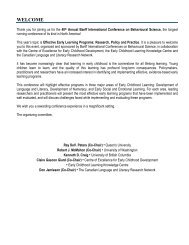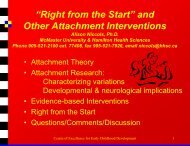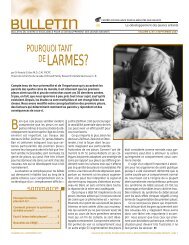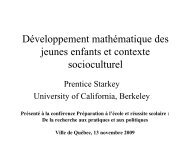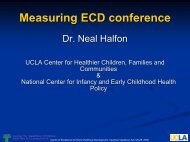Bulletin - The measure of excellence : Canadian early childhood ...
Bulletin - The measure of excellence : Canadian early childhood ...
Bulletin - The measure of excellence : Canadian early childhood ...
You also want an ePaper? Increase the reach of your titles
YUMPU automatically turns print PDFs into web optimized ePapers that Google loves.
SPECIAL FEATURE ON RESEARCH: BEHAVIOURBOYHOOD AGGRESSION: WHO IS AT RISK AND WHY?In the spring <strong>of</strong> 1984, an ambitiouslongitudinal study <strong>of</strong> physicalaggression in boys began. <strong>The</strong>subjects were 1,037 French-speakingkindergarten boys from lowsocio-economic areas in Montreal.<strong>The</strong>y were assessed regularly fromthe age <strong>of</strong> six until they were fifteenyears old.Over the years,the researchersidentified four different kinds <strong>of</strong> aggressiveboys: chronic aggressors, high butdeclining aggressors (very aggressiveboys whose aggression diminished asthey matured) moderate but decliningaggressors(moderately aggressive boyswho tempered their aggression as theymatured), and low aggressors.<strong>The</strong> studyestablished that most boys reducedtheir level <strong>of</strong> physical aggression as theygrew older, while a small group (3%)maintained high levels <strong>of</strong> aggression.<strong>The</strong> researchers wondered if itwould be possible to identify boys atrisk <strong>of</strong> chronic physical aggressionfrom the time they entered school.Further study revealed that those whoremained physically aggressive untiladolescence tended to be hyperactive,highly oppositional and have low verbalIQs. Particularly worrisome was thecombination <strong>of</strong> hyperactivity and highopposition.Together,these two factorsincreased a boy's odds <strong>of</strong> becoming achronic aggressor eightfold.When researchers turned theirattention to the parents to determinewhat family characteristics (ifany) might predict the boys' aggressivetendencies, their findings weresomewhat surprising. A father'ssocio-economic and educational statusappeared to have no effect whatsoeveron a boy's risk <strong>of</strong> chronicaggression. It was the mother's agewhen she gave birth to her first childand her level <strong>of</strong> education that mattered.Thus, the son <strong>of</strong> a teenagedmother who had received limitedschooling was nine times more likelyto become a chronic aggressor.Sylvie Fortin, who heads up theFamily-Child-Youth program at theAssociation des CLSC et des CHSLDdu Québec notes that the study hasimportant implications for healthpr<strong>of</strong>essionals. Helping young womenavoid unwanted pregnancies in theirteens is crucial, according to Fortin.But providing support to teen mothersis also essential. We must "helpyoung mothers provide a stable andsupportive environment for their children.Mothers should be helped todevelop long-term plans and a strongsocial network to break down isolationfrom peers," Fortin says.Given the strong link betweenhyperactivity and long-termaggression shown in the study,Fortin says that there is a vital needto identify hyperactive children at avery young age and provide themwith appropriate services. She notesthat this kind <strong>of</strong> program has beeninstituted in Quebec and targetsschool-aged children. Fortinexpects that the program will beextended to preschool-aged children,adding that we need "anapproach that brings together family,daycare services and schools forthese children."Ref.: D. S. Nagin and R. E. Tremblay."Parental and Early ChildhoodPredictors <strong>of</strong> Persistent PhysicalAggression in Boys from Kindergartento High School." Archives <strong>of</strong> GeneralPsychiatry.Vol. 58. April 2001.ARE CHILDHOOD TRAUMAS AND EATING DISORDERS RELATED?Do <strong>childhood</strong> traumas such asphysical or sexual abuse makewomen more likely to developbulimia nervosa later in life? Currentresearch suggests that <strong>childhood</strong>abuse is associated with anomalousserotonin and cortisol functioningin the body. Studies <strong>of</strong> bulimicwomen also show this same anomaly.Reduced serotonin activity isassociated with mood disorderssuch as depression and reduced cortisol(the stress hormone) activity toprolonged intense stresses.A Quebec research team decidedto examine the activity <strong>of</strong> serotoninand cortisol in four groups: Abusedbulimic and non-abused bulimicwomen, and abused and non-abusednormal eaters. <strong>The</strong> researchers foundno systematic association between<strong>childhood</strong> abuse and bulimia.However, they did find that bulimicwomen were much more likely to sufferfrom major depression. As well,symptoms <strong>of</strong> post-traumatic stressdisorder (PTSD) occurred significantlymore <strong>of</strong>ten in abused bulimic women.As in previous studies, the researchteam found reduced serotonin activityto be associated with both bulimia and<strong>childhood</strong> abuse. However, lowercortisol activity was only associatedwith abuse, not with bulimia. Fromthese findings, the researchers speculatethat the same vulnerability thatmakes a woman more likely to developbulimia may make her more vulnerableto the detrimental effects <strong>of</strong> abuse.This vulnerability may be manifestedon the neurobiological level asreduced cortisol activity and at thebehavioural level as PTSD symptoms."<strong>The</strong>re have been questions aboutwhether or not <strong>childhood</strong> abuse wasa causative factor in eating disorders,but research has failed to show causation,"noted Katherine Austin Leonard,Medical Director <strong>of</strong> the EatingDisorders Program at North YorkGeneral Hospital and a lecturer in theUniversity <strong>of</strong> Toronto's Division <strong>of</strong>Adolescent Medicine. "<strong>The</strong>se findingsare consistent with prior studies. It isan elegant study and the researchershave been very responsible with theirconclusions,” said Leonard.As a clinician working with eatingdisorder patients and their families,Leonard has seen many abusedbulimic women who also suffer fromPTSD and self-destructive behavior, afinding consistent with the results <strong>of</strong>this study. "This finding may be helpfulto patients in terms <strong>of</strong> understandingtheir symptoms," sheadded. Patients might also want toknow about the changes in serotoninactivity associated with bulimia."<strong>The</strong>re were significant biologicalmarkers for eating disorders andabuse," Leonard said. "Understandingthe biological factors in eating disordershas become increasingly importantin terms <strong>of</strong> treatment.""Usually I'm very cautious about findingsfrom small studies such as this one,"said Leonard. "However, their findingswere striking, and they were very <strong>measure</strong>dand careful in their conclusions."Ref.: H. Steiger et al. "Association <strong>of</strong>Serotonin and Cortisol Indices WithChildhood Abuse in Bulimia Nervosa."Archives <strong>of</strong> General Psychiatry. Vol. 58.September 2001.VOLUME 1, N O 3 - DECEMBER 2002 BULLETIN OF THE CENTRE OF EXCELLENCE FOR EARLY CHILDHOOD DEVELOPMENT - PAGE 11



